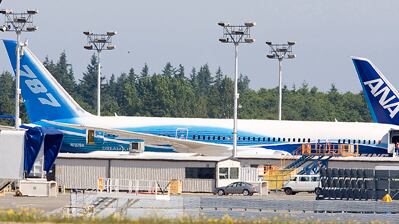
Boeing is facing the most embarrassing and costly debacle in its history. Today’s announcement that the 787 Dreamliner’s first flight has been postponed, due to the discovery of a structural flaw, is the latest in a series of poorly explained delays. The program is already two years late. In the company’s history, there has never been such a gulf between the brilliance of the concept behind an airliner and the ability of the company to deliver it. Make no mistake, the 787 was—and probably will be—a game-changer. Scores of airlines around the world have ordered it. Today, all of them are wondering: What is really the problem?
It was a Potemkin Village of technology, camera-ready but a long way short of leaving the ground.
It all looked very different two years ago when the first 787 was rolled out with a great deal of hoopla. It turned out that that 787 was a hollow shell. It looked every bit the sleek precursor of a new age of fuel-efficient, passenger-friendly machines it was cracked up to be. But in truth, it had no moving parts at all, except its wheels.
It was a Potemkin Village of technology, camera-ready but a long way short of leaving the ground.
Since then, the repeated delays have all had one acknowledged cause: building the entire airplane from composites, not metal. This was exacerbated by having to bring together many parts outsourced from many countries. If you set out to build a whole airplane in a way that never been done before, glitches are bound to surface. But none of this implied that there was anything inherently risky that would make the 787 unsafe to fly.
So today’s revelation, that there was “a need to reinforce an area within the side-of-body section” means, when translated, that there was a suspicion that part of the airframe would fail if the first 787 left the ground in that condition. There was more. Boeing said that they considered a temporary fix that would allow the 787 to fly as scheduled, but decided instead to “develop, design, test and incorporate a permanent modification.”
It may sound judicious, but it indicates a substantial new delay. “Develop” is not a word used lightly. Preceding “design” implies trial and error. Even more disingenuously, the announcement added: “Structural modifications like these are not uncommon in the development of new airplanes.” Given the history of the 787, that’s just hogwash.
The fundamental problem with the 787 has always been that Boeing was attempting to combine many streams of untried technical innovation into one design and, at the same time, setting wildly optimistic deadlines for completion.
Several years ago, I visited a well-concealed complex behind a furniture showroom in suburban Seattle. It contained a full-size mockup of the 787’s cabin. Designers walked me through the concept. It was truly transforming—deep windows, airy spaces and cleverly thought through details. This was truly the future of flying, as advertised.
But now Boeing is exposed as a victim of its own propaganda, forcing its engineers to meet goals that were never remotely realistic. One wonders how one man feels about this today: Alan Mulally, now the CEO of the Ford Motor Co. Mulally moved from Boeing to Ford a year before the rollout of the 787. I met Mulallly when he was CEO of Boeing Commercial Airplanes. He had had an impressive record, and came across as a hard-driving visionary and great leader. There’s a lot of Mulally DNA in the 787. And if he had been running the 787 program, I would bet that it would be in a lot better shape today.
Clive Irving is senior consulting editor at Condé Nast Traveler, specializing in aviation.






